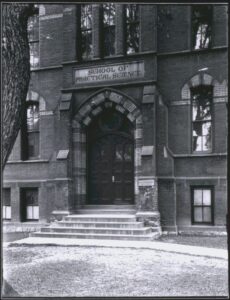
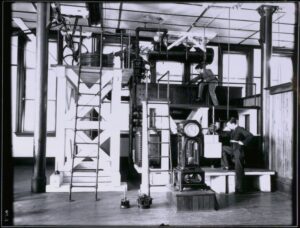
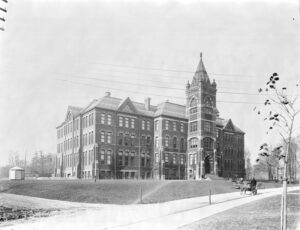
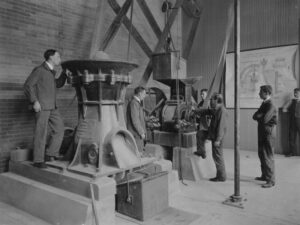
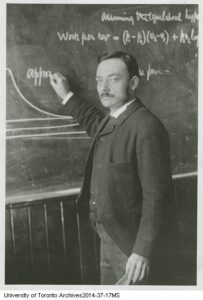
In 2018, the name of the Department of Civil Engineering was formally changed to the Department of Civil & Mineral Engineering. This story is being updated to be inclusive of, and reflect the varying elements of, our shared history.
The Civil Engineering profession can be traced back to the earliest sedentary human settlers, people who abandoned the nomadic lifestyle of their ancestors in favour of permanent, built settlements. Archaeologists date the earliest of these settlements at approximately 2000-4000 BC. At this time, the focus of civil technology was on construction and structural projects: the creation of buildings that offered protection from weather, animals, and enemies, and religious monuments and temples that could accomodate a burgeoning population. Transportation also became increasingly important as more nomadic people began to settle and permanent trade routes and territories were established. As populations expanded, the earliest environmental engineering projects emerged to find solutions for sanitation, drinking water, and public health issues.
The massive expansion of empires later required advanced road systems, aqueducts, bridges, fortresses and large-scale public gathering places. This development continued and became more advanced through the Middle Ages and, after the population boom that occurred during the Industrial Revolution, became more important than ever.
- 1851: University College begins to offer a course in Civil Engineering. Seven students later complete the program.
Here in the Department of Civil Engineering at the University of Toronto, we trace our roots back to the merger of the newly-formed Ontario School of Practical Science with the individual courses in Civil Engineering that had been offered by University College, University of Toronto since the 1850s.
 Left: University College, 1875.
Left: University College, 1875.
The Ontario School of Practical Science was established in 1873 by order of Provincial Parliament, and began a full program of study in 1878. The School had a general mission to promote and enhance the industrial and economic capacity of the still new Province of Ontario and, in a larger sense, the Dominion of Canada as a whole.
The University of Toronto already existed at this time as an arm's-length, self-funded institution of higher learning under the auspices of the Province. It was, however, still primarily focused on traditional modes of intellectual pursuit and had not developed an interest in applied knowledge for the new industrial economy. Lacking an established Chair in the civil engineering discipline, the course in Civil Engineering consisted primarily of theoretical, academic sciences.
Because of this, and the desire to ensure that the new school could focus specifically on practical applications of the sciences, the School of Practical Science was established as a separate, but complimentary, entity to the University of Toronto. The legislative paperwork was signed into law in January 1871 by the government of Sandfield MacDonald.
Later that same year, the government secured $50,000 in public funds and purchased a building at the corner of Church and Adelaide Streets to be remodelled into the first School of Practical Science in Canada. The School's first classes were to instruct professional engineers in the mining, civil and mechanical disciplines as well as workers in wood, leather, wool, flax, modellers, carvers, and applied chemistry.
Unfortunately, before the School could properly open, MacDonald's government fell and was replaced by an opponent to the creation of a separate professional school, Edward Blake. Blake favoured the creation of a school under the auspices of the existing University of Toronto and, instead of allowing the School of Practical Science to begin its full regimen at its opening, opened the school as the College of Technology, offering simple night classes that taught drafting and chemistry exclusively.
In 1873 the Government of Oliver Mowat, following Blake's lead, took the legislative steps to create a full school for "mining, engineering, mechanics and manufactures" that would be fully controlled by the Provincial Government but which would have, from its outset, a strong link to University College at the University of Toronto. Thus, what would become the Department of Civil Engineering at the University of Toronto had been founded as the Ontario School of Practical Science.
- John Galbraith, MA., LLD., In Charge of Civil Engineering, SPS, 1878-1901
- Skule's first Alumnus, Mr. James L. Morris, SPS Civil Engineering, 1881
As a result of the administrative efforts of James Loudon, an instructor affiliated with the University of Toronto, the Government announced in 1876 that it was selling the downtown College of Technology Building and erecting a new one on the grounds of the University of Toronto, just South-East of University College. The Ontario School of Practical Science was built in 1877-1878 in full conjunction with the University of Toronto as the Applied Science Department of University College.
Following some politically intriguing debate, John Galbraith, BA., MA.,University College, was hired to be the first Professor of Engineering and would become the School's champion for years to come. Galbraith had come highly recommended by his peers and professional associates, having built himself a successful engineering practice with ties to the railways, mechanics, and other public projects. He formally took office on September 28, 1878, just in time to begin teaching that year.
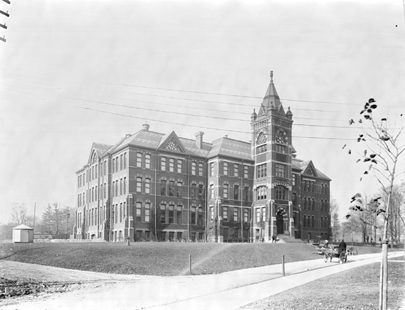 Left: The SPS (Engineering) Building, affectionately known as the Little Red Schoolhouse.
Left: The SPS (Engineering) Building, affectionately known as the Little Red Schoolhouse.
The Little Red Schoolhouse, as it came to be known, was a small, three-storey brick building that stood on the current site of the Medical Sciences Building at the top of King's College Road. The facility housed lecture space, offices and aboratories for applied geology, mineralogy, chemistry, and civil engineering. The building was modest, to say the least, especially having been built in the shadow of the magnificent stone edifice that is University College.
The School of Practical Science offered a three-year practical diploma program in three areas: Engineering (meaning Civil, Mechanical, and Mining Engineering), Assaying and Mining Geology, and Analytical and Applied Chemistry. The School also offered a one-year certificate program in Surveying. In its first year, the School saw 8 full-time regular engineering students; this grew to 12 by the following year. Enrollment rose steadily despite tuition fees of $80 per year, including books and laboratory fees.
James L. Morris became the first alumnus of SPS in 1881, graduating with a Civil Engineering Certification three years after classes began.
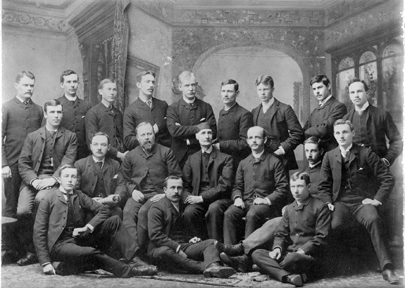 Left: The SPS Graduating Class, 1888.
Left: The SPS Graduating Class, 1888.
The University of Toronto had graduated seven students in the informal civil engineering course between the years of 1851 and 1884. In 1884 the University of Toronto Senate established a new professional Civil Engineer degree designation in place of the old certification offered by University College. The new degree formally required the completion of the three-year SPS diploma in Civil Engineering along with three years of work experience and the completion of a formal thesis (with drawings) on a topic related to the field. Having been the first to graduate from SPS in 1881, James Morris now had his three years of work experience logged and became the first to graduate from the University of Toronto as a Civil Engineer as well, in the spring of 1884.
- First 4-year Alumnus: Mr. T.H. Alison, SPS Civil Engineering 1892, BASc 1893 (University of Toronto)
- Louis Beaufort Stewart, In Charge of Civil Engineering (Surveying & Geodesy), 1901-1931
- John Galbraith becomes first Dean of the Faculty of Applied Science & Engineering, University of Toronto, 1906.
In 1892 the SPS began to offer an optional fourth year, the completion of which would allow graduates to become eligible to apply for the new Bachelor of Applied Science designation at the University. The first to accomplish this was T.H. Alison, a graduate of SPS in 1892 and of the University of Toronto in 1893.
In 1900 ties between the School of Practical Science and the University of Toronto had become so close and intertwined that it would no longer be prevented: the SPS was dissolved and formally became the Faculty of Applied Science and Engineering at the University of Toronto.
By 1909, the three-year diploma originally offered by SPS was phased out, making way for a new, mandatory four-year degree program leading to the Bachelor of Applied Science degree fully certified by the University.
 Left: John Galbraith, Professor of Civil Engineering, First Head of Civil Engineering, First Dean of the Faculty of Applied Science and Engineering, University of Toronto ca. 1908.
Left: John Galbraith, Professor of Civil Engineering, First Head of Civil Engineering, First Dean of the Faculty of Applied Science and Engineering, University of Toronto ca. 1908.
- John Galbraith, MA., LLD., In Charge of Civil Engineering, SPS, 1878-1901
- Louis Beaufort Stewart, In Charge of Civil Engineering (Surveying and Geodesy), 1901-1931
- Peter Gillespie, In Charge of Civil Engineering (Municipal & Structural), 1920-1929
- Clarence Richard Young, Head of Department of Civil Engineering (Municipal & Structural), 1929-1945
- William Manton Treadgold, Head of Department of Civil Engineering (Surveying & Geodesy), 1931-1953
- Thomas Richard Loudon, Head of Department of Civil Engineering (Municipal & Structural), 1945-1953
- Head of Department, 1953-1954.
- Carson Frederick Morrison, Head of Department of Civil Engineering, 1954-1968
- Mark William Huggins, Acting Head, Department of Civil Engineering, 1963-1964
- Theodore Cameron Kenney, Chairman of Department of Civil Engineering, 1968-1974
- Gerhard William Heinke, Chairman of Department of Civil Engineering, 1974-1984
- S.M. Uzumeri, Chairman of Department of Civil Engineering, 1984-1989
- R.M. Soberman, Chairman of Department of Civil Engineering, 1989-1995
- Barry J. Adams, Acting Chair, Department of Civil Engineering, 1994-1995
- Chair, Department of Civil Engineering 1995-2003
- Eric J. Miller, Acting Chair, Department of Civil Engineering, 1998-1999, 2003, 2007
- R. Paul Young, Chair, Department of Civil Engineering, 2004-2007
- Brenda Y. McCabe, Chair, Department of Civil Engineering, 2008-2013
- Brent Sleep, Chair, Department of Civil Engineering, 2013-2018
- Chair, Department of Civil & Mineral Engineering, 2018-2023
- Marianne Hatzopoulou, Chair, Department of Civil & Mineral Engineering, 2023-present
Harris, Robin S. and Montagnes, Ian [Eds.]. Cold Iron and Lady Godiva: Engineering Education at Toronto, 1920-1972. Toronto: University of Toronto Press, 1973.
Levine, Barry G. A Century of Skill and Vigour. Toronto: Barry G. Levine, 1985.
White, Richard. The Skule Story: The University of Toronto Faculty of Applied Science and Engineering, 1873-2000. Toronto: University of Toronto Press, 2000.